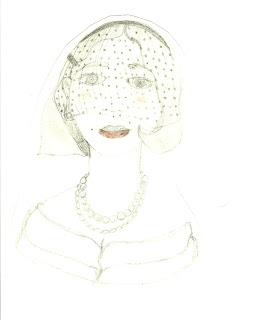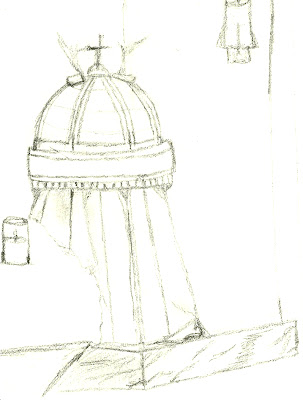Now I am going to put a "Don't trust everything you read on the Internet" here...3...2...1.. Okay.
But I believe this is pretty solid. A CIA Case worker on the project, Donald Jameson, spoke out about what the CIA did in those early days. But if it is a big hoax, it is well thought out and worth thinking about in a day like ours when art seems to be cut instead of funded.
It makes sense. Apparently the CIA infiltrated theater, writing, and art, as a way of promoting American visuals and culture. They wanted to play up the differences between Russia and the US. Russia was stuck in a time of Socialist Realism in its art work. Abstract Expressionism was so Avant-garde and different that it made Russia's art at the time seem antiquated and stylized. It is a great publicity tool. ---Don't look to the old Russian ways, look to the fresh new, American and Western European Movements!
RUSSIA Socialist Realism
 |
Vladimirski, Boris Eremeevich (1878-1950) "Roses for Stalin" Date: 1949 |
USA Abstract Expressionism
Montauk Highway/ Willem de Kooning (Netherlands, active United States, 1904-1997) |
 |
Jackson Pollock (American, 1912–1956)One: Number 31, 1950 ON View at MoMA in NYC |
I guess my mind is blown, because When I hear about the reception of Abstract Expressionism, I don't think of many "Square people" to use the slang of the time, jumping up and down to support it... I think of people saying "That isn't art". And many of these artists and playwrights and people seemed to lean more towards the left, towards socialist policies. These artists seemed to be anti government and establishment. But that is discussed in the article.
"Matters of this sort could only have been done at two or three removes," Mr Jameson explained, "so that there wouldn't be any question of having to clear Jackson Pollock, for example, or do anything that would involve these people in the organization. And it couldn't have been any closer, because most of them were people who had very little respect for the government, in particular, and certainly none for the CIA. If you had to use people who considered themselves one way or another to be closer to Moscow than to Washington, well, so much the better perhaps." -Donald Jameson
However, Jackson Pollock was in Life and Time Magazine. Abstract Expressionists did take over every gallery form the late 40's to the early 60's.There works ended up in government buildings and prestigious galleries. But then I think of the McCarthy era where these artists as well as writers and film makers were all black listed, or tried as communists. It all seems almost too hard to believe.
Now, this may make some people say, this undermines the movement and A.E. would never have become what it was without government help! But I don't believe that is true. The USA was moving towards a change after WWII. It wanted new, fresh, and things that were American. I believe it would have caught on just as it did... but if the CIA really was involved... maybe it just caught on a little faster.
I would like to believe this article is true, not just so when my friends who don't "get" Abstract Expressionism say "I can do that" or "That isn't art" I can say "WHY DON"T YOU LOVE AMERICA!?!" But also because it shows the government taking a real interest in art, and seeing how useful it can be. I feel, like I am sure many artists feel, that people take art for granted. It is not as appreciated as it should be. Art programs are cut before sports programs. Many grants and programs that once helped art flourish are gone. but then I hear about programs as in this article, or other government programs that supported Fine Arts, such as the WPA (The Works Progress Administration) or The Federal Arts Project, or The Federal Writers' Project, which all gave money to artists during the depression to create cultural and beautification projects. These programs created jobs for artists and raised moral during the depression. http://www.indiana.edu/~liblilly/wpa/wpa_info.html
This article makes me think, why are we cutting art programs, when art could be so useful? Could we use art to fight hate and terrorism? Absolutely! Can we use art to teach children to think creatively and critically? Yes! I even read a study recently that measure how much morale rose when a person went to an art show or theatrical performance. It rose exponentially and significantly improved the quality of life. I will post the name of the study here once my supervisor sends it to me. (It is very interesting. I suggest reading it.) Or in this recession we are experiencing, wouldn't it be nice to have something like the WPA to raise morale through beautification projects and create jobs? (See my previous post about The Mural Arts Project in Philadelphia). http://emmanuellewambach.blogspot.com/2013/03/amazing-street-art-site.html
I suppose I am just angry with the situation of art today. Other questions arise like, would many artists see taking government money as "selling out"? Would the art have to change to be more what the government wanted? I guess it is a double edged sword. I was just intrigued and blown away to see how art was once seen by even the highest in government as a valuable tool for world change and prosperity. It still is, and can be today... but it is hard to think that it is appreciated when I see art budgets get cut everyday and programs wiped away.
But yes, this was a very interesting article. Sorry for getting all preachy at the end there.

.bmp)









.bmp)



















